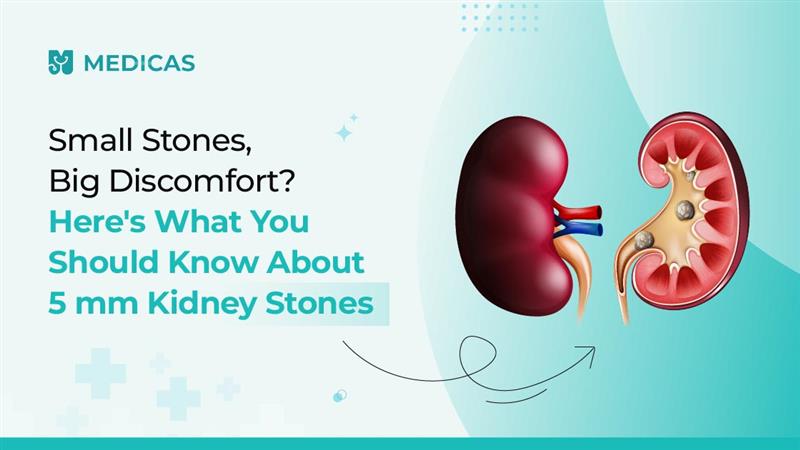That tiny 5 mm stone in your kidney? It can cause big trouble. Despite being just the size of a sesame seed, it can lead to sharp pain and endless discomfort. If you’re searching for answers or wondering what comes next, you’re in the right place. This blog covers everything you need to know—what a 5 mm kidney stone means, how it’s treated in India, and ways to prevent it from returning.
Understanding Kidney Stones
What is a Kidney Stone?
A kidney stone is a hard, crystalline mineral buildup that forms in the kidneys when urine becomes supersaturated with certain substances. These calculi often comprise calcium oxalate, uric acid, struvite, or cystine, depending on various metabolic factors.
Normal Kidney Stone Size in mm
The normal size of a kidney stone in mm ranges between 1 and 4 mm, which usually passes naturally without major issues. However, once a stone grows beyond 4 mm, it’s more likely to cause complications or get stuck in the urinary tract.
Is a 5mm Kidney Stone Big or Dangerous?
A kidney stone size 5mm falls on the higher end of what’s likely to pass naturally. While it isn’t extremely large, it can cause intense pain, block urine flow, and lead to infections or kidney damage if left untreated. It’s essential to monitor the size of the kidney stones and seek medical guidance if symptoms arise.
Causes of a 5mm Kidney Stone
Dietary and Lifestyle Factors
High sodium and animal protein diets raise urinary calcium levels, increasing the risk of calcium oxalate stones. Eating oxalate-rich foods like spinach, nuts, and chocolate without enough calcium further adds to the risk.
Dehydration and Fluid Imbalance
Dehydration reduces urine volume, concentrating minerals like calcium and oxalate, which crystallize and form kidney stones over time.
Genetic and Medical Conditions?
Family history and metabolic disorders (hyperparathyroidism, cystinuria, gout) can predispose individuals to stone formation. Conditions like hyperparathyroidism raise serum calcium levels, fostering recurrent stones unless treated.
Symptoms of a 5mm Kidney Stone
Common Symptoms to Watch for
- Sharp pain in the lower back or abdomen
- Painful urination
- Blood in the urine (pink or reddish tint)
- Nausea or vomiting
- Frequent urge to urinate
When to Seek Medical Help
- Pain becomes unbearable
- Urine output decreases
- Fever and chills occur
- Blood is consistently visible in urine
Seek immediate medical attention if these symptoms persist despite standard kidney stone treatment. You can also consult with me directly via Medicas. https://www.blogs.medicasapp.com/sediment-in-urine.
Also Read: 7 Urine Colors: A Comprehensive Guide to Normalcy and When to Seek Medical Attention
Diagnosis of 5mm Stone
Tests Used to Detect Kidney Stones
Diagnosis typically begins with a physical examination and detailed patient history. The doctor may recommend tests such as:
- Urinalysis (to detect crystals, blood, or infection)
- Blood tests (to check calcium or uric acid levels)
Imaging and Lab Tests
Advanced imaging techniques help in locating the stone and evaluating its size and position.
- Ultrasound: Common and radiation-free.
- CT Scan: High accuracy for all stone sizes.
- X-rays: Used in some cases for follow-up.
You can book lab tests online through healthcare platforms that offer at-home sample collection and fast results.
Online Diagnostic Consultations
Can’t visit a clinic? No problem. With today’s digital health services, you can get preliminary advice, upload test results, and get prescriptions through online doctor consultation—all from the comfort of your home.
Kidney Stone Treatment Options
What is the Treatment for Kidney Stones?
For a 5mm stone size, treatment options include:
- Medical management: Hydration, pain relief.
- Shock Wave Lithotripsy (SWL): Breaks stones for easier passage.
- Ureteroscopy: Removes or breaks stones using a thin tube.
- RIRS: Using a Flexible scope to break and remove kidney stones.
Is a 5mm Kidney Stone Dangerous Without Treatment?
Without kidney stone treatment, a 5 mm stone can cause obstruction, recurrent infections, hydronephrosis, and potential loss of kidney function over time.
Kidney Stone Pain Relief Tablets in India
Pain from kidney stones can be intense. Doctors may prescribe:
- NSAIDs (nonsteroidal anti-inflammatory drugs)
- Antispasmodics to relax urinary muscles
- Alpha-blockers to ease stone passage
Self-medication is not recommended, always consult a doctor first.
Comparing Kidney Stone Sizes and Implications
Kidney Stone Size 5mm vs. 4.5 mm Kidney Stone
Though a 4.5 mm kidney stone may seem close in size, even a 0.5 mm difference can affect passage potential. Most stones under 5 mm pass naturally; those at or above may require treatment.
5.5 mm Kidney Stone: Does 0.5 mm Matter?
Absolutely. A 5.5 mm kidney stone may be just half a millimetre larger than a 5 mm stone, but the chances of it passing naturally drop sharply. This size often requires medical procedures, making early detection critical.
Also Read: Haemoglobin in Urine: Unveiling the Causes, Diagnosis & Treatment
Lifestyle and Prevention Tips
Diet and Hydration Guidelines
To prevent stones or aid in flushing them out:
- Drink at least 8–10 glasses of water a day
- Reduce salt and animal protein
- Eat calcium-rich but low-oxalate foods
- Avoid cola, sweetened beverages, and caffeine
Preventing Future Stones
Once you’ve had a stone, you’re more likely to develop another. Preventive tips include:
- Monitoring your urine pH
- Taking doctor-prescribed supplements (if needed)
- Following up with regular tests
Daily Habits for Kidney Health
- Maintain a healthy weight
- Exercise regularly
- Avoid high-dose vitamin C supplements
- Follow a routine to avoid dehydration
When to Consult a Doctor
Which Treatment is Best for Kidney Stones?
The best kidney stone treatment depends on the size, location, and symptoms. Early consultation improves outcomes.
Online Doctor Consultations for Kidney Stones
If you’re experiencing symptoms or have test results in hand, consult a urologist via online doctor consultation. Medicas offer:
- Expert guidance
- Prescriptions & diet tips
- Option to book appointments or book lab tests online
When Surgical Intervention is Required
Consider surgical options if the stone is >10 mm, causing refractory pain, obstruction, or recurrent infections.

Conclusion
While a 5 mm kidney stone can be painful, timely treatment and preventive care can make all the difference. For expert guidance, personalized treatment, or quick online consultations, book an appointment with Medicas today.
Frequently Asked Questions (FAQs)
- How long does it take to pass a 5mm stone naturally?
It varies. Some people pass a 5mm stone in a few days, while for others, it may take weeks. Hydration, activity, and medications can help.
- What home remedies can help relieve pain from a 5mm stone?
Home remedies like barley water, lemon juice in warm water, and coconut water can aid in stone movement and provide mild pain relief. Always pair with medical advice.
- Do kidney stone symptoms differ by size?
No. Sometimes smaller stones can cause severe symptoms and larger stones sometimes may be asymptomatic.
- How to book an online appointment for kidney stone diagnosis?
To book an online appointment for kidney stone diagnosis, simply visit the Medicas app or website, choose a urologist, and schedule your consultation in a few clicks.
Related Blogs
Disclaimer
Medical Advice: The information provided in this blog post is for educational purposes only and should not be considered as a substitute for professional medical advice, diagnosis, or treatment. Always consult with a qualified healthcare professional for personalized guidance regarding your specific medical condition.
Accuracy of Information: While we strive to provide accurate and up-to-date information, the field of medicine and viral fevers is constantly evolving. The content in this blog post may not reflect the most current research or medical guidelines. Therefore, it is advisable to cross-check any information provided with reliable sources or consult a healthcare professional.
Individual Variations: The symptoms, causes, treatment options, and preventive measures discussed in this blog post are general in nature and may not apply to everyone. It is important to remember that each individual’s situation is unique, and personalized medical advice should be sought when making healthcare decisions.
External Links: This blog post may contain links to external websites or resources for additional information. However, we do not endorse or have control over the content of these third-party websites. Accessing these links is done at your own risk, and we are not responsible for any consequences or damages that may arise from visiting these external sources.
Results May Vary: The effectiveness of treatment options or preventive measures mentioned in this blog post may vary from person to person. What works for one individual may not work the same way for another. It is essential to consult with a healthcare professional for personalized advice tailored to your specific needs.

Dr. Anuj Arora is a Consultant Urologist and Uro-Oncologist based in Greater Noida and Noida, with over 13 years of medical experience. He completed his MBBS and MS from Maulana Azad Medical College, Delhi, and MCh in Urology from Sri Ramachandra Medical College, Chennai. Dr. Arora has worked with top hospitals including Apollo Spectra and Max Super Speciality Hospital. His areas of expertise include Endourology, Kidney Transplantation, Robotic Urology, and Uro-Oncology. He is a member of USI, UAA, and AUA.


